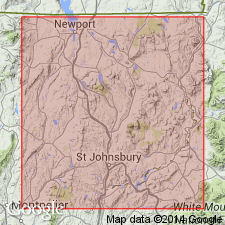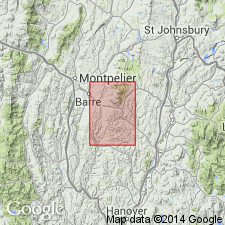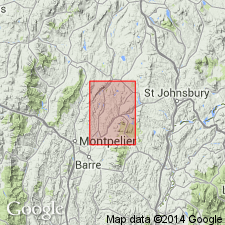
- Usage in publication:
-
- Knox Mountain granite
- Modifications:
-
- Original reference
- Dominant lithology:
-
- Granite
- AAPG geologic province:
-
- New England province
Summary:
Mentioned Knox Mountain granite in Orange, northeastern Vermont (coarser than Kirby granite), age unknown; Kirby granite on Kirby Mountain [eastern part of Kirby Township, Caledonia County, northeastern Vermont]; Barre granite; Bethel granite; and Woodbury granite. The latter 3 granites are now [ca. 1936] assigned to Devonian.
[See also C.H. Richardson, 1902, 3rd Rpt. Vermont State Geol., diagrammatic cross sections across Washington and Orange Cos., p. 27, 1902.]
Source: US geologic names lexicon (USGS Bull. 896, p. 1115).

- Usage in publication:
-
- Knox Mountain granite
- Modifications:
-
- Areal extent
- Dominant lithology:
-
- Granite
- AAPG geologic province:
-
- New England province
Summary:
Pg. 79-81. Knox Mountain granite. Medium-grained, light-gray granite similar to Barre granite, but is lighter in color and not as homogeneous. Composed of quartz, potash feldspar, plagioclase (oligoclase), biotite, and muscovite. Accessory minerals include sphene, apatite, epidote, and magnetite. Pegmatitic dikes and quartz veins common. Outcrop area extends from East Barre area [this report] northward into Plainfield and St. Johnsbury quadrangles. Although a separate name is given to this granite, Knox Mountain granite and Barre granite may be separate outcrops of a single plutonic body. No positive evidence to attest such relationship attainable for this report. Age not stated. Rb/Sr age determination on Barre granite gave 330 +/-25 Ma. This suggests a Silurian age for the granite, but it is only slightly higher for Middle Devonian.
Named from Knox Mountains in East Barre quadrangle, Washington Co., VT.
Source: US geologic names lexicon (USGS Bull. 1200, p. 2045); GNU records (USGS DDS-6; Reston GNULEX).

- Usage in publication:
-
- Knox Mountain Granite
- Modifications:
-
- Areal extent
- AAPG geologic province:
-
- New England province
Summary:
The Knox Mountain granite extends from the center of the East Barre quad. northeast through the Plainfield quad. and into the western part of the St. Johnsbury quad. It appears likely that the entire 7 by 20 mile elliptical area is underlain by similar plutonic rocks. The contact with the adjacent Waits River and Gile Mountain formations may be traced by a mixed border zone. The Knox Mountain granite differs from the Woodbury granite in that the Knox Mountain is poorer in plagioclase and mica and richer in potash feldspar and quartz. The Knox Mountain is of Devonian age.
Source: GNU records (USGS DDS-6; Reston GNULEX).
For more information, please contact Nancy Stamm, Geologic Names Committee Secretary.
Asterisk (*) indicates published by U.S. Geological Survey authors.
"No current usage" (†) implies that a name has been abandoned or has fallen into disuse. Former usage and, if known, replacement name given in parentheses ( ).
Slash (/) indicates name conflicts with nomenclatural guidelines (CSN, 1933; ACSN, 1961, 1970; NACSN, 1983, 2005, 2021). May be explained within brackets ([ ]).

